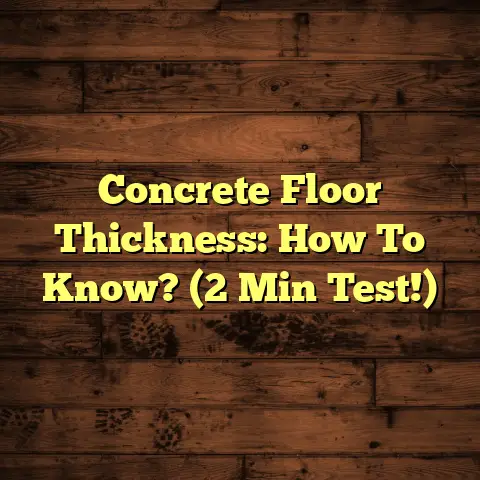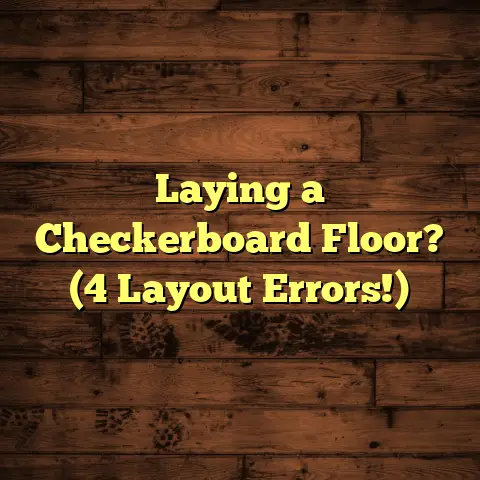Calculate Garage Floor Slope? (2% is the Magic!)
Ever walked into a garage and just felt…right?
Noticed how the space seemed to effortlessly handle water, kept things dry, and was just plain comfortable to use?
A big part of that feeling comes down to something you might not even think about: the garage floor slope.
I’m going to walk you through why that subtle incline is so crucial, and why a 2% slope is often considered the “magic” number for garage floors.
Section 1: Understanding Garage Floor Slope
So, what exactly is garage floor slope?
Simply put, it’s the intentional angling of your garage floor to allow water to drain properly.
Think of it like this: your garage floor isn’t perfectly flat; it has a slight decline, usually towards the door.
Why does it matter?
Well, without a slope, rainwater, melting snow, or even just washing your car can lead to water accumulation inside your garage.
This can cause a whole host of problems:
-
Damage to your belongings: Think stored boxes, tools, or even your vehicle.
-
Mold and mildew growth: A damp environment is a breeding ground for these unwanted guests.
-
Cracked concrete: Water that freezes and thaws can wreak havoc on your concrete floor.
-
Safety hazards: Standing water can be a slip-and-fall risk.
The basic principle at play here is gravity.
A sloped floor uses gravity to direct water away from the back of the garage and towards the opening, preventing pooling and keeping the space dry.
Now, let’s talk about that “magic” number: 2% slope.
A 2% slope means that for every 100 inches (or feet, if you prefer) of horizontal distance, the floor drops 2 inches.
This incline might seem minimal, but it’s often the sweet spot for effective drainage without making the slope noticeable or causing issues with parking vehicles or moving items around.
To give you a better idea, here’s a simple diagram:
High Point (Back of Garage)
|
| 2 inches (Rise)
| /
| /
|/
-------------------- 100 inches (Run)
Low Point (Garage Door)
Section 2: The Importance of a 2% Slope
Why is 2% considered the gold standard?
Well, it’s a balance.
Too little slope, and water won’t drain effectively, leading to all the problems we discussed earlier.
Too much slope, and you’ll start noticing it.
Parking cars can become a hassle, items might roll around, and it can even be a tripping hazard.
A 2% slope provides adequate drainage without being overly noticeable or creating usability issues.
Think of it this way: it’s like Goldilocks and the Three Bears – not too much, not too little, but just right!
Let’s dive a bit deeper into the implications of having too little or too much slope:
Too Little Slope (Less than 2%):
-
Water Pooling: The most obvious issue. Water accumulates, leading to potential damage and hazards.
-
Increased Humidity: Standing water increases humidity levels in your garage, which can damage tools and equipment.
-
Salt and Chemical Buildup: If you live in an area with snow, road salt can accumulate in the standing water, damaging your concrete over time.
Too Much Slope (More than 2%):
Vehicle Issues: Parking can be tricky, especially with certain vehicle types.
You might find your car rolling slightly even with the parking brake on.-
Storage Problems: Items can roll or slide, making it difficult to store things securely.
-
Accessibility Concerns: A steep slope can be challenging for people with mobility issues.
Now, let’s talk about some real numbers.
According to a study by the International Code Council (ICC), a minimum slope of 1% is required for drainage in most concrete slabs.
However, many contractors, including myself, prefer the 2% slope for garages to provide an extra margin of safety and ensure effective drainage even under heavy rainfall or snowmelt.
I have personally seen countless garages with slopes less than 2% struggle with water issues, leading to costly repairs and headaches for homeowners.
On the flip side, I’ve also encountered garages with excessive slopes that made parking and storage a nightmare.
The 2% slope truly hits that sweet spot for optimal performance.
Section 3: Calculating the Slope of Your Garage Floor
Alright, let’s get down to the nitty-gritty: how do you actually calculate the slope of your garage floor?
Don’t worry, it’s not rocket science!
The formula is simple:
Slope = Rise / Run
-
Rise: The vertical change in height (in inches or centimeters).
-
Run: The horizontal distance over which the rise occurs (in inches or centimeters).
To calculate the slope, you’ll need a few tools:
-
Level: A good quality level is essential for accurate measurements.
-
Measuring Tape: To measure the rise and run.
-
Chalk Line (Optional): For marking a straight line across the floor.
-
Straight Edge (4-foot or longer): A long, straight board or metal ruler.
Here’s a step-by-step guide:
-
Choose a starting point: Select a spot at the back of your garage (the highest point).
-
Mark a line: Use the chalk line (if you have one) to mark a straight line from the back of the garage to the front (towards the garage door).
-
Place the straight edge: Place the straight edge along the marked line, ensuring it’s level at the starting point.
Measure the rise: Measure the distance between the bottom of the straight edge and the floor at the garage door (the lowest point).
This is your “rise.”Measure the run: Measure the horizontal distance from the starting point to the garage door.
This is your “run.”Calculate the slope: Divide the rise by the run.
Multiply by 100 to express the slope as a percentage.
Example:
Let’s say your garage is 20 feet (240 inches) long.
You level a straight edge and measure a rise of 4.8 inches.
Slope = 4.8 inches / 240 inches = 0.02
Slope (%) = 0.02 * 100 = 2%
Therefore, your garage floor has a 2% slope!
Here are a couple more examples with different garage sizes:
Garage Size: 24 feet (288 inches) long
Measured Rise: 5.76 inches
Slope = 5.76 inches / 288 inches = 0.02
Slope (%) = 0.02 * 100 = 2%
Garage Size: 18 feet (216 inches) long
Measured Rise: 4.32 inches
Slope = 4.32 inches / 216 inches = 0.02
Slope (%) = 0.02 * 100 = 2%
As you can see, the rise will vary depending on the length of your garage, but the target slope remains at 2%.
Section 4: Practical Applications of the 2% Slope Calculation
When might you need to apply this 2% slope calculation in the real world?
Here are a few scenarios:
New Construction: If you’re building a new garage, ensuring the proper slope is crucial from the start.
Work with your contractor to incorporate the 2% slope into the concrete slab design.Renovations: If you’re renovating an existing garage, you might want to check the slope and make adjustments if necessary.
This could involve resurfacing the floor or adding a self-leveling compound to create the desired slope.Repairs: If you’re repairing a damaged garage floor, it’s a good opportunity to address any slope issues.
Patching or replacing sections of the floor can allow you to correct the slope.
Incorporating the 2% slope into your garage design involves considering a few key factors:
Flooring Materials: The type of flooring material you choose can affect the ease of achieving the desired slope.
Concrete is the most common material, but epoxy coatings or tile can also be used.Structural Elements: Be mindful of any structural elements in your garage, such as support beams or columns.
These might affect the direction of the slope or require adjustments to the floor design.-
Door Threshold: Ensure that the garage door threshold is properly sealed to prevent water from entering the garage, even with the slope.
Common Challenges and Solutions:
-
Existing Floor with Insufficient Slope: If your existing garage floor has too little slope, you can use a self-leveling concrete compound to build up the floor and create the desired incline.
Uneven Floor: If your floor is uneven, you’ll need to address these imperfections before calculating the slope.
Use a concrete grinder or patching compound to create a smooth, even surface.Limited Headroom: In some garages, headroom might be a concern.
Adding a significant slope could reduce the available headroom, so you’ll need to carefully consider the trade-offs.
Section 5: Real-World Examples and Case Studies
Let’s take a look at some real-world examples to illustrate the impact of garage floor slope:
Case Study 1: The Waterlogged Garage
A homeowner in Minnesota contacted me after experiencing persistent water pooling in their garage during the winter months.
Their garage floor had a slope of only 0.5%, which was far too little to effectively drain the melting snow and ice.
The water caused damage to their stored belongings and created a breeding ground for mold.
To fix the problem, we applied a self-leveling concrete compound to increase the slope to 2%.
We also installed a new garage door threshold to prevent water from seeping in.
The homeowner reported a significant improvement in drainage, and their garage is now dry and mold-free.
Case Study 2: The Rolling Car
Another homeowner in California complained that their car would slowly roll forward even with the parking brake engaged.
Upon inspection, we discovered that their garage floor had an excessive slope of 4%.
This made parking difficult and created a safety hazard.
To correct the slope, we ground down the high points of the concrete floor and applied a new concrete overlay to create a more gradual incline.
The homeowner is now able to park their car safely and without any rolling issues.
Feedback from Homeowners and Contractors:
I’ve spoken with countless homeowners and contractors about the impact of garage floor slope.
The consensus is clear: a properly sloped garage floor is essential for preventing water damage, maintaining a dry environment, and ensuring the usability of the space.
Homeowners consistently report that a 2% slope provides the optimal balance between drainage and usability.
Contractors agree that incorporating the proper slope into the garage design is a best practice that can save homeowners time, money, and headaches in the long run.
Section 6: Conclusion: The Lasting Benefits of a Properly Sloped Garage Floor
So, there you have it!
We’ve covered everything you need to know about calculating garage floor slope and why a 2% slope is often considered the “magic” number.
Remember, a properly sloped garage floor is not just about aesthetics; it’s about protecting your belongings, preventing water damage, and ensuring the safety and usability of your space.
By taking the time to assess or plan your garage floor with the 2% slope in mind, you’re investing in the long-term health and functionality of your home.
Don’t underestimate the impact of this seemingly small detail.
A well-designed garage floor can make a world of difference in your everyday comfort and peace of mind.
So, grab your level, measuring tape, and chalk line, and get to work!
Your garage will thank you for it.





